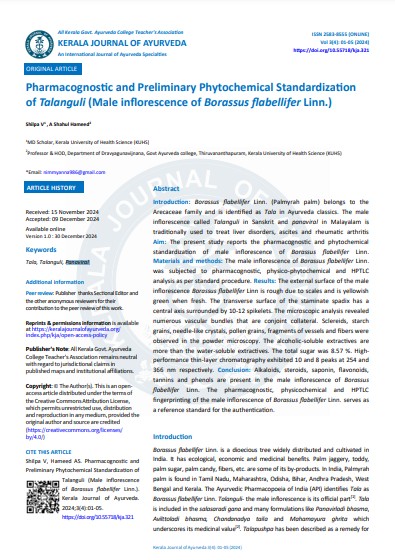Pharmacognostic and Preliminary Phytochemical Standardization of Talanguli (Male inflorescence of Borassus flabellifer Linn.)
DOI:
https://doi.org/10.55718/kja.321Keywords:
Tala, Talanguli, PanaviralAbstract
Introduction: Borassus flabellifer Linn. (Palmyrah palm) belongs to the Arecaceae family and is identified as Tala in Ayurveda classics. The male inflorescence called Talanguli in Sanskrit and panaviral in Malayalam is traditionally used to treat liver disorders, ascites, and rheumatic arthritis Aim: The present study reports the pharmacognostic and phytochemical standardization of male inflorescence of Borassus flabellifer Linn. Materials and methods: The male inflorescence of Borassus flabellifer Linn. was subjected to pharmacognostic, physico-phytochemical, and HPTLC analysis as per standard procedure. Results: The external surface of the male inflorescence Borassus flabellifer Linn is rough due to scales and is yellowish green when fresh. The transverse surface of the staminate spadix has a central axis surrounded by 10-12 spikelets. The microscopic analysis revealed numerous vascular bundles that are conjoint collateral. Sclereids, starch grains, needle-like crystals, pollen grains, fragments of vessels, and fibers were observed in the powder microscopy. The alcoholic-soluble extractives are more than the water-soluble extractives. The total sugar was 8.57%. High-performance thin-layer chromatography exhibited 10 and 8 peaks at 254 and 366 nm respectively. Conclusion: Alkaloids, steroids, saponin, flavonoids, tannins, and phenols are present in the male inflorescence of Borassus flabellifer Linn. The pharmacognostic, physicochemical, and HPTLC fingerprinting of the male inflorescence of Borassus flabellifer Linn. serves as a reference standard for the authentication.
References
Warrier P K, Nambiar V P, Ramankutty C, Indian Medicinal Plants a Compendium of 500 Species. Vol 1. Arya vaidyasala Kottakkal, Hyderabad: Orient Longman Ltd;1994 ,p 293.
Ministry of Health and Family Welfare, Department of AYUSH. THE AYURVEDIC PHARMACOPOEIA OF INDIA. p-212. (Part 1; vol. 3).
Chakrapanidatta. Chakradatta(Chikitsa Sangraha). first. Varanasi: chaukambha orientalia; 2014. 376 p.
Kasiramar, Gopalasatheeskumar & K, Saranya & G, Arulkumaran. (2019). An Updated Overview on Phytochemical screening and Pharmacological Screening of Borassus flabellifer linn. 2347-7881. 10.29161/PT.v7.i5.2019.15.
Kritikar KR, B.D. Basu. Indian Medicinal Plants. Vol. 4. Dehradun: International Book Distributors; 2571 p. 6. Tunit P, Thammarat P, Okonogi S, Chittasupho C. Hydrogel containing Borassus flabellifer L. male flower extract for antioxidant, antimicrobial, and anti-inflammatory activity. Gels. 2022 Feb 17;8(2):126.
https://ijpt.iums.ac.ir/article-1-267-fa.html.
http://hdl.handle.net/10603/131401.
Kalaichelvi, K.; Dhivya, S.M. Screening of phytoconstituents, UV-VIS Spectrum and FTIR analysis of Micrococca mercurialis (L.) Benth. Int. J. Herb. Med. 2017, 5, 40–44.
Morlock, G. ManMohan Srivastava (Ed.): High-performance thin-layer chromatography (HPTLC), 1st ed. Anal Bioanal Chem 401, 2331–2332 (2011). https://doi.org/10.1007/s00216-011-5299-2.
Behera S, Nayak B. Phytochemical Constituents and Nutritional Potential of Palmyra Palm: A Review.
Anonymous. The Ayurvedic Pharmacopoeia of India. Part II. 1st ed., Vol. II. New Delhi: Government of India, Ministry of Health and Family Welfare, Department of AYUSH; 2008. p. 159‑61.
Ministry of Family and Health Welfare Government of India. Ayurveda Pharmacopoeia of India. 1st ed. Part-1Vol 7 Appendix 2.2; 2007. 140 p.
Department of AYUSH. Ayurvedic Pharmacopoeia of India, Part II (Formulations). New Delhi: Government of India, Ministry of Health and Family Welfare; 2008.
Mbaebie BO, Edeoga HO, Afolayan AJ. Phytochemical analysis and antioxidants activities of aqueous stem bark extract of Schotia latifolia Jacq. Asian Pac J Trop Biomed. 2012 Feb;2(2):118-24. doi: 10.1016/S2221-1691(11)60204-9. PMID: 23569880; PMCID: PMC3609248.
Di Carlo G, Mascolo N, Izzo AA, Capasso F. Flavonoids: Old and new aspects of a class of natural therapeutic drugs. Life Sci. 1999 Jun;65(4):337–53.
DE Okwu. Phytochemicals and vitamin content of indigenous spices of South Eastern Nigeria. J Sustain Agric Environ. 2004;n, 6 (1): 30-37.© 2014.
Sieniawska E. Activities of Tannins--From In Vitro Studies to Clinical Trials. Nat Prod Commun. 2015 Nov;10(11):1877–84.
Gunjal, Sanket & R, Dighe. (2022). Analysis of Herbal Drugs by HPTLC: A REVIEW. Asian Journal of Pharmaceutical Research and Development. 10. 125-128. 10.22270/ajprd.v10i2.1056.
Thin-layer chromatography evaluation. https://www.merckmillipore.com. Accessed 6 Nov 2020.





